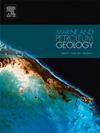Qualitative characterization of sandbody connectivity for meandering river composite channel sandbody at seismic scale with large well spacing
IF 3.7
2区 地球科学
Q1 GEOSCIENCES, MULTIDISCIPLINARY
引用次数: 0
Abstract
Studying the static connectivity of reservoir is essential to predict the lateral connectivity of sandbodies and devise field development strategies. Critical elements of static connectivity include geometry, stacking pattern, and the distribution of sandstone bodies. The meandering river reservoir in the lower member of the Minghuazhen (Nm) Formation is intersected and superimposed by multi-stage channel sandbody, resulting in a complex sandbody architecture. However, in the early phase of oilfield development with limited well data and sparse well spacing, there is a lack of comprehensive characterization of the strongly heterogeneous distribution pattern of channel sandbody and an incomplete understanding of sandbody connectivity, which complicates the optimization of well placement. We conducts a precise analysis of sandbody connectivity at different levels in seismic scale for Lm733 sandbody of the V oil group in the lower section of the Nm Formation, based on a comprehensive utilization of geological data in oilfield and guided by sequence stratigraphy and seismic sedimentology applying stratigraphic proportional slicing and sandbody edge detection technique. The results indicate that Lm733 sandbody can be classified into two composite channel sandbodies, respectively distributed in the early sequence (SQ1) and late sequence (SQ2). Based on the diverse seismic reflection characteristics, varying thicknesses, and plane distribution features of the interbed, the connectivity between two composite channel sandbodies for SQ1 and SQ2 could be classified into three categories (Type-Ⅰ, Ⅱ, and Ⅲ). According to the seismic attribute variation, including amplitude, waveform, and frequency at the internal boundaries of composite sandbodies, the internal connectivity of composite sandbody in SQ2 can be classified into three categories (Type-1,2, and 3), in conjunction with the existing injection-production well pattern. In this manner, predicting the characterization of sandbody connectivity at various levels in composite channel sandbody at seismic scale can aid in adjusting oilfield development plans.
求助全文
约1分钟内获得全文
求助全文
来源期刊

Marine and Petroleum Geology
地学-地球科学综合
CiteScore
8.80
自引率
14.30%
发文量
475
审稿时长
63 days
期刊介绍:
Marine and Petroleum Geology is the pre-eminent international forum for the exchange of multidisciplinary concepts, interpretations and techniques for all concerned with marine and petroleum geology in industry, government and academia. Rapid bimonthly publication allows early communications of papers or short communications to the geoscience community.
Marine and Petroleum Geology is essential reading for geologists, geophysicists and explorationists in industry, government and academia working in the following areas: marine geology; basin analysis and evaluation; organic geochemistry; reserve/resource estimation; seismic stratigraphy; thermal models of basic evolution; sedimentary geology; continental margins; geophysical interpretation; structural geology/tectonics; formation evaluation techniques; well logging.
 求助内容:
求助内容: 应助结果提醒方式:
应助结果提醒方式:


